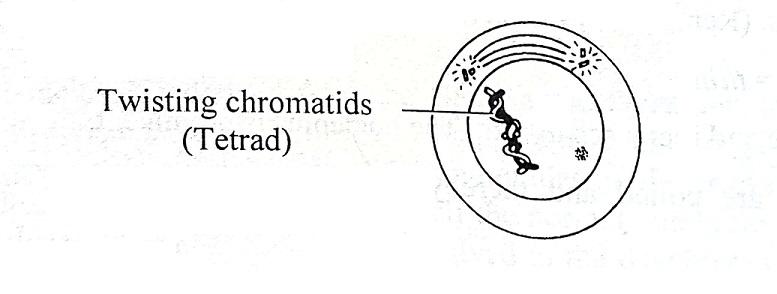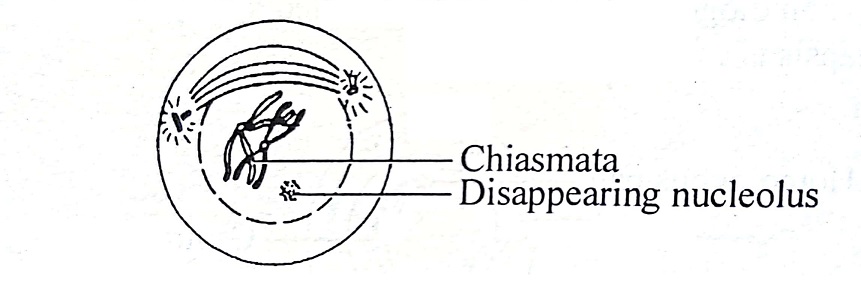
What is meiosis?
- The term meiosis is derived from the Greek word ‘meioum’ which means to reduce.
- It is a special kind of cell division, occurring in sexually reproducing organisms. It occurs only in gonads (testes and ovaries in animals and anthers and ovules in higher plants) to produce gametes.
- It also occurs in sporangial sacs to produce sporangiospores in lower plants and fungi that reproduce asexually by sporulation.
- Meiosis is a type of cell division where one mother cell divides to produce four haploid daughter cells with half the normal number of chromosomes than in the parent or mother cell itself.
- Since the number of chromosomes is halved in the daughter cells, the process is also called reductional cell division. For example, a diploid human cell has 46 (23 pairs) chromosomes, one set (23) coming from the male gamete and another set (23) chromosome from the female gamete.
- When the opposite gametes fuse, a diploid zygote is formed which divides by mitosis. So, every cell of human body has 46 chromosomes except for gametes. The sperms in males and ova in females however, have 23 chromosomes only.
- In each diploid cell, there are two identical chromosomes forming a pair, called a homologous pair of chromosomes. There are 23 such homologous pairs of chromosomes in a diploid human cell. Only one chromosome of each pair is present in a haploid cell (gamete).
How many nuclear divisions occur in meiosis?
- Meiosis consists of two successive nuclear divisions with only a single doubling of the DNA amount or chromosomes. These divisions are called first and second meiotic divisions.
- During the first meiotic division, the homologous chromosomes pair up. The pair then separates, one member going to each of the daughter cells. It is important to note that the centromere doesn’t divide. This division halves the chromosome number of the parent cell. The two daughter cells thus formed have half the number of chromosomes contained in the parent cell. Hence, this division is also called reductional division.
- During the homologous pairing, each chromosome within a pair may swap DNA. The exchange of genetic material between the non-sister chromatids in a homologous pair occurs at specific points of contact called chiasmata (plural: chiasma) and is referred to as crossing over. Due to crossing over, the newly formed chromosomes are unique and created genetic variation in the gametes produced. Each of the four cells produced by meiosis are genetically different to each other and to the parent cell.
- In the second meiotic division, chromatids of each chromosome separate at the centromere and move to opposite poles. The separated chromatids are now referred to as new chromosomes. When the chromosomes reach the opposite poles of the cell, new nuclear membranes form around them. Each daughter cell splits into two forming four haploid cells in total.
- During spermatogenesis (formation of sperms) in males, four sperms are produced from one parent cell during meiosis whereas in females, during oogenesis (formation of ovum or egg), four daughter cells are produced from one mother cell, however, only one of them becomes an ovum or egg with three other degenerating.
Meiosis I (First meiotic division):
- Meiosis, like mitosis, also consists of five stages; Interphase, Prophase I, Metaphase I, Anaphase I and Telophase I.
- It is a heterotypic division (reducing the chromosome number from diploid to haploid).
- Interphase:
- It prepares the cell for successful division.
- As in mitosis, the cell grows in size.
- Copying of all the chromosomes occurs with nucleus having distinct mebranes.
- Prophase I:
- The meiotic prophase first is of extremely long duration compared with mitotic prophase and comprises of the following five sequential sub-stages; Leptotene, Zygotene, Pachytene, Diplotene and Diakinesis.
- Leptotene:
- The nucleus is large and increases in size. The nucleolus is prominent.
- The chromosomes are coiled and thereby become visible as thread-like structures, and intermingled.
- Leptotene:
-
-
- The chromosomes are double-stranded even though they appear to be single stranded.
- Chromosomes have a beaded appearance due to the fact that the chromatin is coiled around histone proteins to form nucleosomes. The number, size and position of genes are constant and identical in homologous chromosomes.
- In animal cells, the centrosome divides and moves towards opposite poles as centrioles.
- Zygotene:
- Homologous chromosomes (one maternal and one paternal) come close together and make pairs called homologous pairs. These pairing of homologous chromosomes is called synapsis. Each pair of homologous chromosomes in synapsis is called a bivalent.
-
-
-
- The pairing of the homologous chromosomes is very accurate and involves point to point pairing over the entire length of homologous chromosomes.
- The chromosomes undergo further coiling and condensation. They become shorter and more distinctly visible.
- The nucleolus further increases in size and centrioles move further apart.
- Pachytene:
- The paired chromosomes of each bivalent become more shortened, thick and clearly distinct. At this stage, synapsis is fully completed.
- Each chromosome splits longitudinally (lengthwise) into two sister chromatids. Each pair of chromosomes now consists of four chromatids and is called a tetrad.
- The non-sister chromatids of a tetrad twist around each other and touch each other at different points of contact.
-
-
-
- An exchange of chromatids segments occurs between the two non-sister chromatids of each homologous pair after coiling around each other. This is called crossing over. During crossing over, the non-sister chromatids of a tetrad break at identical points. The broken segment of one chromatid joins with the non-sister chromatid of its tetrad at different points. This point of interchange and rejoining of the chromatids appear ‘X’ shaped and is a called chiasma (plural: chiasmata). Simply put, crossing over occurs at chiasma.
- Diplotene:
- The paired homologous chromosomes begin to separate from each other due to repulsive force and start moving away from one another.
-
-
-
- The separating non-sister chromatids of a homologous pair remain attached at some points called chiasma.
- Nucleolus and nuclear membrane begin to disappear.
- Diakinesis:
- Further shortening and condensation of chromosomes occur. The chromosomes move to the periphery of the nucleus.
- Chiasmata moves towards the end of the chromosomes. This process is called terminalization of chiasmata.
-
-
-
- Nucleolus and nuclear membrane continue disappearing, marking the end of prophase I.
- In animal cells, centrioles reach their respective poles of the cell and start forming spindles.
-
- Metaphase I:
- The chromosome tetrads (four chromatids) lie on the equatorial plane of the spindle fibers.
- Spindle formation is complete and several spindle fibers are attached to the centromeres of the chromosomes.
- The nuclear membrane and nucleolus completely disappear.
- Anaphase I:
- The two chromosomes of a homologous pair separate from each other and move to opposite poles of the cell as they are pulled apart by the shortening of spindle fibers. Unlike anaphase of mitosis, centromeres of each chromosome don’t divide.
-
- By the end of anaphase I, two groups of haploid chromosomes are formed one on each pole of the spindle. The consequence of this stage of meiosis is the reduction of the chromosome number by one half from the diploid. However, the chromatids of these chromosomes are not genetically identical because of crossing over. This is the essential difference between meiosis and mitosis. The chromosomes at the poles are either from the father or the mother.
- Telophase I:
- At each pole, chromosomes lose their identity and change into chromatin network.
- Nucleolus completely disappears.
- Nuclear membrane reappears around the chromatin network and two daughter nuclei are formed.
-
- Each daughter nucleus thus formed, has half the number of chromosomes possessed by the parent cell nucleus. This condition is called haploid (n). Thus, two haploid nuclei are formed which is followed by cytokinesis resulting in the formation of two haploid daughter cells.
Meiosis II (Second meiotic division):
- Interphase between the first and second meiotic divisions is either absent of if present is of very short duration.
- The two haploid cells formed by the first meiotic pass through four sub-stages; Prophase II, Metaphase II, Anaphase II and Telophase II.
- This second meiotic division is a mitotic division forming daughter cells with same chromosome number as the parent cell, thus called homotypic division.
- The changes occur simultaneously in both the haploid cells.
Also see: Differences between Mitosis and Meiosis
- Prophase II:
- The chromatin network changes to chromosomes due to condensation. The nuclear membrane and nucleolus disappear.
- Each chromosome consists of two distinct chromatids attached to the single centromere.
- The centriole duplicates and move to the opposite poles.
- The spindle fibers start to appear.
- Metaphase II:
- The spindle formation is complete. The chromosomes, each of which have chromatids, arrange themselves along the equatorial plane of the spindles.
- The centromere of each chromosome gets attached with the spindle fibers.
- Anaphase II:
- The centromere of each chromosome divides and separates so that each chromatid (now behaving like a chromosome) has its own centromere.
- The separated chromatids move away from each other to the opposite poles which are now called chromosomes.
- Telophase II:
- The chromosomes of each group become long and thin and form a network of chromatin.
- The nuclear membrane is formed around them and are organized into a nucleus.
- Spindle fibers disappear and nucleolus reappears.
Cytokinesis:
- The nuclear division is followed by cytokinesis. It starts in Anaphase II and completes in Telophase II.
- The centriole duplicates to form a centrosome in each daughter cell.
- Cytokinesis is completed with the formation of four daughter cells. Each cell has haploid (n) number of chromosomes.
- Thus, meiosis results in the formation of four haploid daughter cells from a single diploid (2n) mother cell.
Significance of Meiosis:
- Stability of living beings (species):
- It reduces the number of chromosomes to half in the daughter cells. The gametes are formed as a result of meiosis. The gametes fuse during fertilization and restore the diploid chromosome number. Thus, it maintains the number of chromosomes from generation to generation in sexually reproducing organisms. In other words, it avoids the multiplication of chromosomes number and maintains the stability of the race of species.
- Genetic difference (Variation):
- Due to crossing over, non-identical cells i.e., gametes are formed. This brings variation in the organisms of the same species. This variation results in evolution in a long run.
Meiotic cell division (Meiosis), its stages and significance











